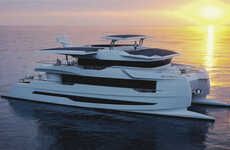The BRIDGES robot glider is Europe's first ever ultra-deep-sea robot glider. Developed by the UK's National Oceanography Centre, this craft will be capable of reaching 75 percent of the world's oceans, and will be able to access depths of up to 5 kilometers.
The robot will be equipped with special operations and communications systems that will make it stable, robust and easy to use. It will also be capable of carrying out autonomous operations.
The BRIDGE robot glider's final tests are scheduled for September 2019 off the coast of Ireland. The contraption's development could have some pretty wide applications. Project leader Dr. Mario Brito says that " the range of sensors this glider can carry makes it well suited to a wide range of applications, both within research and industry."
Pollution-Monitoring Robots
The BRIDGES is an Ultra-Deep-Sea Robot Glider
Trend Themes
1. Ultra-deep-sea Technology - Opportunity for developing advanced technology solutions for exploring and monitoring the depths of the oceans.
2. Autonomous Robotics - Disruptive innovation opportunity to create highly autonomous robots capable of carrying out complex tasks without human intervention.
3. Environmental Monitoring - Potential for leveraging advanced robots to monitor pollution levels and gather environmental data in remote areas.
Industry Implications
1. Ocean Exploration - Opportunity for companies to develop and provide technologies for deep-sea exploration and research purposes.
2. Robotics - Disruptive innovation potential for companies and researchers to advance the capabilities of autonomous robots in various industries.
3. Environmental Science - Application of advanced robotics in environmental monitoring offers opportunities for companies and organizations involved in environmental research and analysis.






